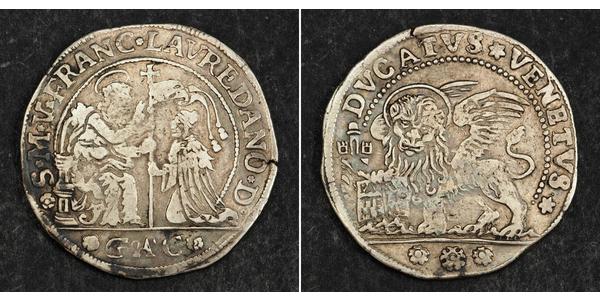1 Ducat (Vendue pour $185.0)
1752, Doges Venice, Francesco Loredan. Beautiful Silver Ducato Coin. VF-aXF!
Mint Year: 1752 Mint Place: Venice Denomination: Ducato Doge: Francesco Loredan (1752-1762) Condition: Dark oxidation deposits near margin in obverse, otherwise a nice VF-aXF! Assayer: Giacomo Antonio Contarini (G.A.C., assayer under this doge during 1752 only!) Reference: Davenport 1551, Papadopouli 33, Montenegro 1580, Gamberini 154.1., KM-C#16. Weight: 22.54gm Diameter: 40mm Material: Silver
Obverse: Lion of St. Mark left, with right paw on book of gospels beneath castle tower. Legend: DVCATVS * VENETVS * Exergue: ***
Reverse: Doge kneeling before nimbate St. Mark seated on throne and receiving docal banner with two long terminals. Legend: *S* M * V * FRANC * LAVREDANO * D . Exergue: *G.A.C*
Bidwith confidence!
The Doge (Venetian language, also Doxe, derived from Latin Dux military leader, duke; cf. English Duke, Italian Duce) was the chief magistrate and leader of the Most Serene Republic of Venice for over a thousand years. Doges of Venice were elected for life by the city-state's aristocracy. Commonly the person selected as Doge was the shrewdest elder in the city. The Venetian combination of elaborate monarchic pomp and a republican constitution with intricate checks and balances makes La serenissima a textbook example of a crowned republic.
According to the chronicler John the Deacon, author of the Chronicon Venetum ("Chronicle of Venice"), written about AD 1000, the office of the Doge was first instituted in Venice about 700, replacing tribunes that had led the cluster of early settlements in the lagoon. Whether or not the first doges were technically local representatives of the Emperor at Constantinople, the doge, like the emperor, held office for life and was similarly regarded as the ecclesiastical, the civil and the military leader, in a power structure termed caesaropapism.
The doge's prerogatives were not defined with precision, and though the position was entrusted to members of the inner circle of powerful Venetian families, after several doges had associated a son with themselves in the ducal office, this tendency towards a hereditary monarchy was checked by a law which were decreed that no doge had the right to associate any member of his family with himself in his office, or to name his successor. After 1172 the election of the doge was finally entrusted to a committee of forty, who were chosen by four men selected from the Great Council, which was itself nominated annually by twelve persons. After a deadlocked tie at the election of 1229, the number of electors was increased from forty to forty-one.
New regulations for the elections of the doge introduced in 1268 remained in force until the end of the republic in 1797. Their object was to minimize as far as possible the influence of individual great families, and this was effected by a complex elective machinery. Thirty members of the Great Council, chosen by lot, were reduced by lot to nine; the nine chose forty and the forty were reduced by lot to twelve, who chose twenty-five. The twenty-five were reduced by lot to nine and the nine elected forty-five. Then the forty-five were once more reduced by lot to eleven, and the eleven finally chose the forty-one who actually elected the doge.
When a new doge was chosen, before he took the oath of investiture he was presented to the people with the formula "This is your doge, if it please you," preserving the fiction that the people of Venice ratified the selection, yet in a real sense the doge was the highest servant of the greater community.
While doges had great temporal power at first, after 1268, the doge was constantly under strict surveillance: he had to wait for other officials to be present before opening dispatches from foreign powers; he was not allowed to possess any property in a foreign land.
The doges normally ruled for life (although a few were forcibly removed from office). After a doge's death, a commission of inquisitori passed judgment upon his acts, and his estate was liable to be fined for any discovered malfeasance. The official income of the doge was never large, and from early times holders of the office remained engaged in trading ventures. These ventures kept them in touch with the requirements of the grandi.
From July 7, 1268, during a vacancy in the office of doge, the state was headed ex officio, with the style vicedoge, by the senior consigliere ducale (ducal counsellor).

|
Posté par:
anonymous 2018-11-13 |
|
||
|
||
|
||
|
||
1/6 Rigsdaler Danemark Argent Frédéric VI de Danemark (1768 ...
Le groupe a 5 pièces / 5 prix
⇑
1 Thaler Saint-Empire romain germanique (962-1806) Argent Fe ...
Le groupe a 2 pièces
⇑




 English
English







-300-150-E0EKbzbiuaQAAAFGGYXW.Z4s.jpg)






